Have you ever wondered what types of spiders live in England? While the country may lack tarantulas, England has its fair share of terrifying spiders crawling around the country! In fact, some of these spiders can grow up to 5 inches long in leg span! Yikes!
In this article, we will explore the world of these unexpectedly giant spiders found in England, exploring their characteristics, habitats, and more. Prepare to have your perception of spiders in England challenged as we uncover the truth about these not-so-tiny creatures.
1. Huntsman Spider (Sparassidae) – 1.8 inches
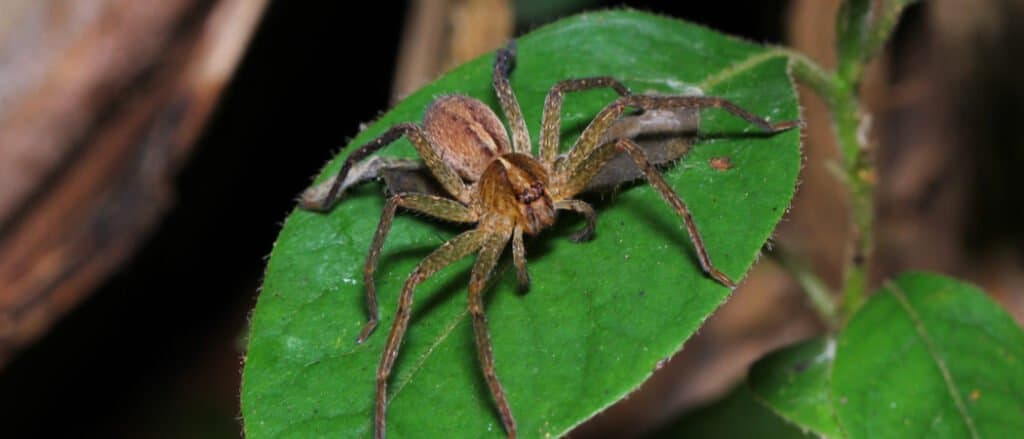
While not a native species in England, the huntsman spider was found in England as recently as 2022!
©Pong Wira/Shutterstock.com
The huntsman spider, though not native to the shores of England, has managed to hitch a few rides into the country, surprising unsuspecting individuals who stumble upon its menacing presence. A notable incident occurred around February 2022 when dock workers in Hull stumbled upon this colossal arachnid in a shipping container. The sheer size of the spider left the workers shocked, prompting them to quickly summon the assistance of the RSPCA (Royal Society for the Prevention of Cruelty to Animals). The officials then carefully captured the spider, which had embarked on a month-long journey worldwide.
The huntsman spider is remarkable in size, boasting a leg span that can reach over an incredible 5 inches and a body length of 1.8 inches. Despite its intimidating appearance, venom, and ability to bite, it is essential to note that its bite is not fatal to humans. However, there have been reports suggesting that the venom of this spider can cause discomforting symptoms such as headaches, vomiting, and even heart palpitations. Therefore, if you ever encounter a huntsman spider, it is crucial to approach them with caution and respect.
The huntsman spider is a formidable hunter. It relies on its remarkable speed and agility to pursue and capture its prey, primarily insects and other small invertebrates. As for its habitat, this spider typically prefers warm and dry environments. It seeks shelter in crevices, cracks, and dark corners, making it a proficient master of disguise. If you ever hope to catch a glimpse of this mighty arachnid, you may have better luck scouring areas such as sheds, garages, and attics, where the spider may have taken up residence within its area.
2. Great Raft Spider (Dolomedes plantarius) – 0.87 inches
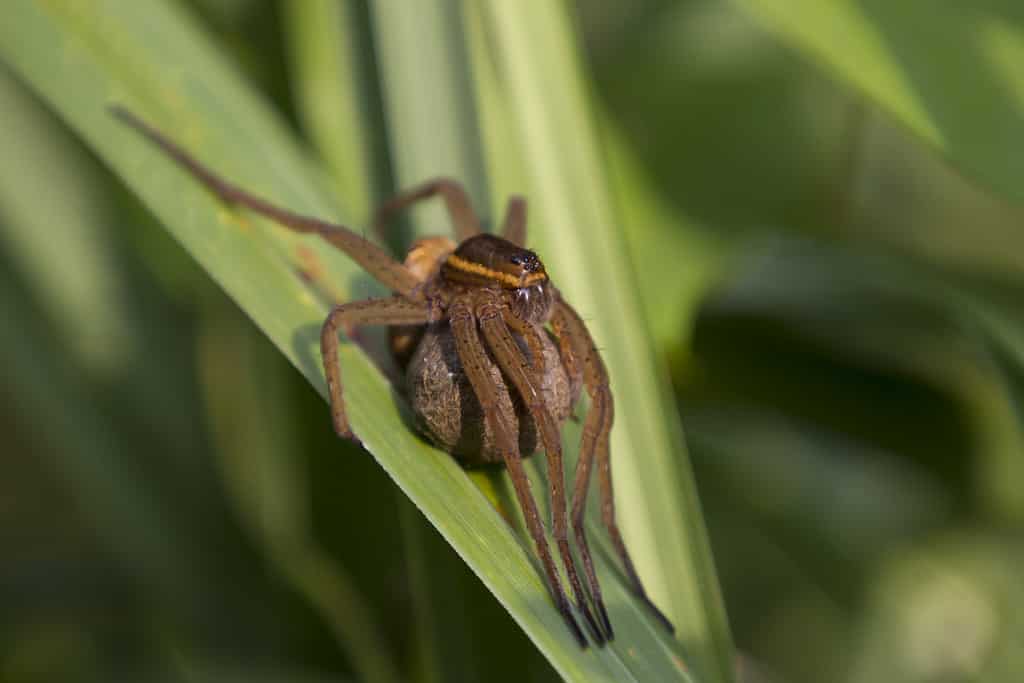
Measuring around 3 inches long in leg span, the great raft spider is one of the biggest spiders in England.
The great raft spider is another arachnid species found in certain UK regions. Its size measures almost 3 inches in leg span and 0.87 inches in body length. This spider has a distinct appearance characterized by its elongated body and agile limbs. Its coloration varies, often displaying shades of brown or gray, which aids in its camouflage within its natural habitat. The great raft spider exhibits fascinating behavior, particularly its adeptness in traversing across water surfaces. With its ability to move swiftly and gracefully, it hunts both on land and in aquatic environments.
As for its diet, the great raft spider is a skilled predator, preying upon various small creatures, such as insects, tadpoles, and even small fish. This spider utilizes its remarkable agility to chase its prey, showcasing impressive hunting tactics. The preferred habitats of the great raft spider are wetland areas, including marshes, fens, and bogs. These locations provide an ideal setting for its hunting endeavors and an ample supply of food sources. However, the great raft spider has become rare in many regions due to habitat loss and degradation.
If you venture into wetland habitats, you may be able to catch a glimpse of the great raft spider. Although it may require patience and careful observation, these spiders can be found in areas with suitable vegetation and water bodies. Their presence is a testament to their remarkable adaptations and highlights the importance of preserving local wetland ecosystems.
3. Cardinal Spider (Tegenaria parietina) – 0.78 inches

Some cardinal spiders can have an incredible leg span of over 4 inches in some cases!
The cardinal spider is an enormous spider in the United Kingdom. Some individuals of this species have a remarkable leg span reaching over 4 inches across! The name “cardinal” holds an intriguing historical connection, as it is said to have originated from a legend dating back to the 14th century. According to the tale, while residing at Hampton Court, Cardinal Wolsey was startled by this formidable spider, leading to the appropriation of its name.
Although the cardinal spider is relatively uncommon throughout Europe, it has a more notable presence in the southern regions of England. These remarkable arachnids often reside in buildings, walls, and human households. They demonstrate unique adaptability to their surroundings and can coexist within human habitats. One of the notable features of the cardinal spider is its ability to endure extended periods without sustenance, showcasing a capacity to withstand dry conditions.
While the cardinal spider can bite, such bites are rare. In fact, the bite of this spider is harmless and painless to humans. Its venom is not known to cause significant adverse effects, so don’t be too afraid of its formidable presence!
4. Labyrinth Spider (Agelena labyrinthica) – 0.71 inches
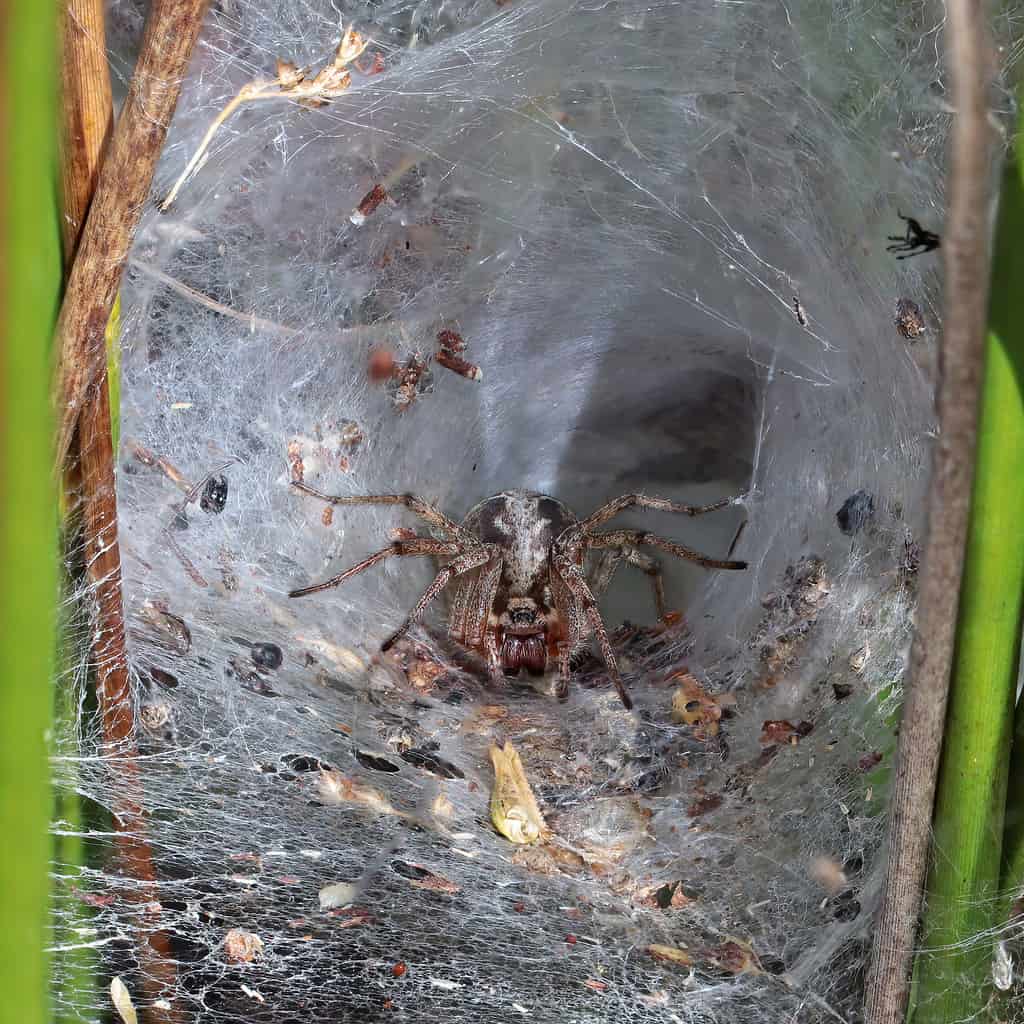
Measuring up to 0.71 inches long, the labyrinth spider spins an interesting web.
The labyrinth spider, another amazing arachnid inhabiting the regions of Wales and England, commonly emerges from June to September, captivating observers with its significant size. This spider measures up to 18mm or 0.71 inches in length. Its preferred habitats include hedges and areas with long grass, where it weaves intricate webs.
The webs created by labyrinth spiders are a remarkable sight to behold, characterized by their exceptional thickness. In specific locations, the density of the web is so pronounced that it appears white in color. As with most other spiders, this web aims to ensnare unsuspecting prey, allowing the spider to secure a nourishing meal. The labyrinth spider primarily sustains itself on various small insects and invertebrates that become entangled in its web.
The labyrinth spider’s habitat choice reflects its ability to thrive in natural settings, making hedges and areas with abundant vegetation its preferred abode. To catch a glimpse of these remarkable creatures, try exploring areas abundant in hedgerows and long grass. You’ll surely be able to come across its elaborate web construction.
5. Four Spot Spider (Araneus quadratus) – 0.66 inches

A distinctive feature of the four spot spider is the four white spots on its back.
©Ian Kirk from Broadstone, Dorset, UK / CC BY 2.0 – Original / License
The four spot spider is another one of the biggest spiders found in England, measuring around 0.66 inches in size. You can observe these captivating creatures in various regions of Britain, particularly in tall grassy areas, during the warmer seasons of summer and fall.
One distinctive feature of the four spot spider is the presence of four white spots adorning its back, hence its name. In addition to the four white spots on their backs, adult four spot spiders are typically brown or reddish-brown in color, which helps them blend in with their surroundings. Their abdomens can vary in shape, ranging from round to slightly elongated.
These arachnids usually mature as adults during the late summer and fall months. During this period, mated females transform remarkably as their bodies become visibly larger due to the presence of eggs. This expansion further contributes to their impressive size.
The four spot spider is known to inhabit tall grassy habitats, where they weave intricate webs to capture their prey. Their diet consists of insects unwittingly ensnared in their silk structures.
6. Giant House Spider (Eratigena atrica) – 0.59 inches
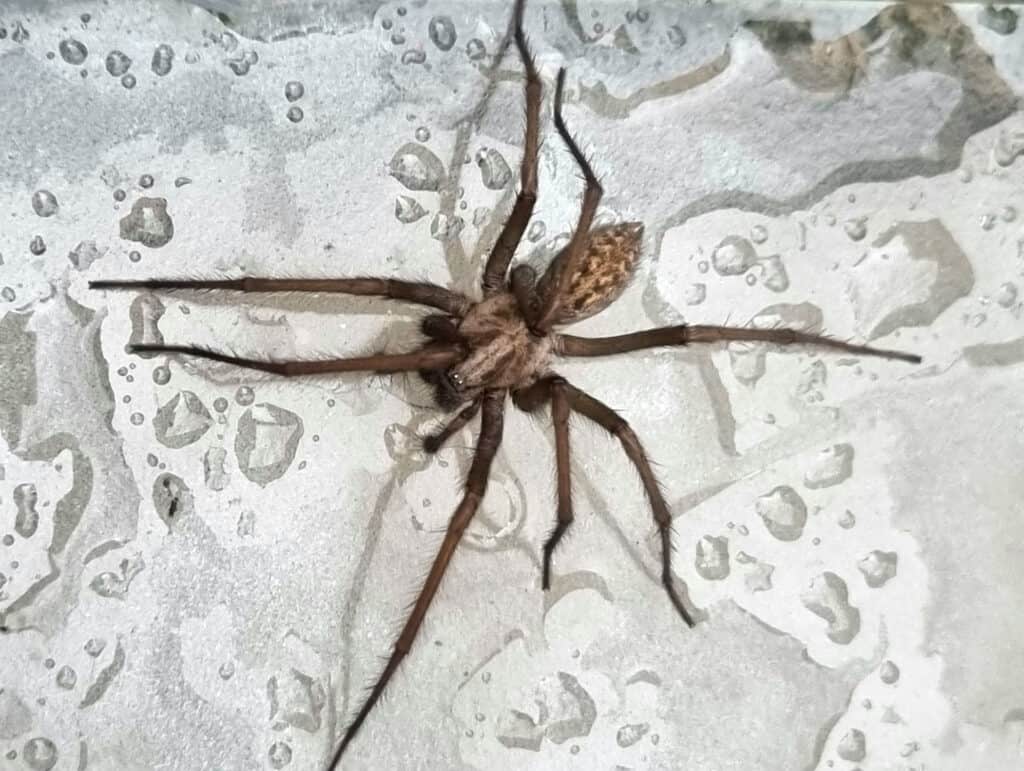
Female giant house spiders are bigger in size than the males.
©iStock.com/Kelly McCutcheon
The giant house spider, known for its impressive size, is one of the biggest arachnids in Britain. Fall is the prime season for encountering this spider, as it becomes more prevalent. These spiders make a striking impression with a potential leg span of over 2 to 4 inches and a body size of 0.59 inches. The female giant house spider is generally bigger in comparison to their male counterparts.
This spider’s preferred habitat encompasses various locations, including sheds, attics, homes, and outbuildings. Interestingly, the giant house spider is incredibly resilient, capable of surviving for several months without access to food or water. But when they do eat, giant house spiders use a combination of speed and agility to skillfully capture their prey.
These arachnids can be observed throughout the year, although their mating season usually occurs in the fall months.
The spider’s presence can often be detected in sheds, garages, attics, and other human structures. Due to their adaptability, these arachnids have managed to coexist with humans and have become well-acquainted with our dwellings, hence their name. So, if you’re curious to encounter this intriguing creature, keep a keen eye while venturing into these common spaces, and you may have the opportunity to observe the giant house spider in its natural habitat.
7. Cellar Spider (Pholcidae) – 0.39 inches
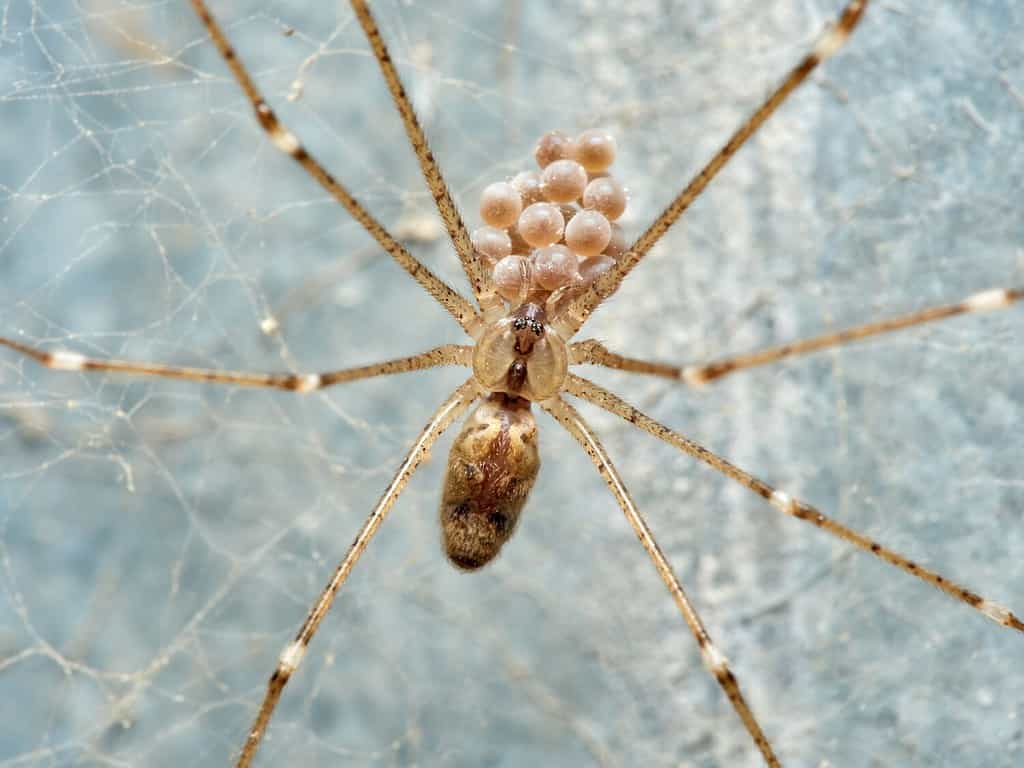
With spindly bodies and long legs, cellar spiders can measure up to 0.39 inches long.
©Macronatura.es/Shutterstock.com
Cellar spiders have distinctive spindly bodies measuring up to 10mm or 0.39 inches long and impressively long legs spanning 5 to 6 times their body size! These fascinating arachnids live in households in England throughout the year, with males boasting an impressive lifespan of up to two years, while females can live up to three years in some cases.
One striking aspect of cellar spiders’ behavior is their unique positioning within their intricate webs. These spiders are known for their inclination to hang upside down from their silk structures. Their choice of orientation is thought to provide them with a good vantage point for capturing prey and detecting potential threats.
Cellar spiders have an appetite for a diverse range of insects and small invertebrates that may unwittingly stumble into their intricately spun webs. This skillful hunting technique showcases the spider’s ability to utilize its environment to secure sustenance.
Given their affinity for indoor environments, cellar spiders can be most commonly encountered within the confines of residential spaces. They are often found in the house’s cellars, basements, and other secluded areas, hence the name “cellar spider.” These arachnids take advantage of the sheltered and relatively undisturbed conditions such locations provide.
Summary of the Biggest Spiders Crawling Around England
| Rank | Spider | Body Size (in Inches) |
|---|---|---|
| 1 | Huntsman Spider | 1.8 |
| 2 | Great Raft Spider | 0.87 |
| 3 | Cardinal Spider | 0.78 |
| 4 | Labyrinth Spider | 0.71 |
| 5 | Four Spot Spider | 0.66 |
| 6 | Giant House Spider | 0.59 |
| 7 | Cellar Spider | 0.39 |
The photo featured at the top of this post is © Luc hoogenstein / CC BY-SA 4.0 – License / Original
Thank you for reading! Have some feedback for us? Contact the AZ Animals editorial team.







